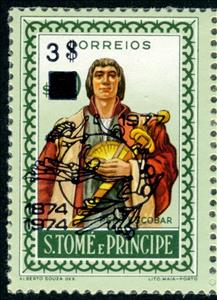Stamp: Pêro Escobar Overprint Type a (São Tomé and Príncipe 1977)
Pêro Escobar Overprint Type a (São Tomé and Príncipe 1977)
19 October (São Tomé and Príncipe ) within release Centenary of membership in UPU goes into circulation Stamp Pêro Escobar Overprint Type a face value 3 São Tomé and Príncipe escudo
| Stamp Pêro Escobar Overprint Type a in catalogues | |
|---|---|
| Stamp Number: | Sn: ST 450 |
Stamp is square format.
Issued with glassine interleaving stuck to back. The series is not listed by SGAlso in the issue Centenary of membership in UPU:
- Stamp - Fernão do Pó Overprint Type a face value 5;
- Se-tenant - Fernão do Pó Overprint Type a & b face value 2*5;
- Stamp - Fernão do Pó Overprint Type b face value 5;
- Stamp - Infantry Corporal, 1788, Overprint Type a face value 35;
- Se-tenant - Infantry Corporal, 1788, Overprint Type a & b face value 2*40;
- Stamp - Infantry Corporal, 1788, Overprint Type b face value 35;
- Stamp - Infantry Officer, 1788, Overprint Type a face value 20;
- Se-tenant - Infantry Officer, 1788, Overprint Type a & b face value 2*20;
- Stamp - Infantry Officer, 1788, Overprint Type b face value 20;
- Stamp - Infantry Sergeant, 1788, Overprint Type a face value 35;
- Se-tenant - Infantry Sergeant, 1788, Overprint Type a & b face value 2*35;
- Stamp - Infantry Sergeant, 1788, Overprint Type b face value 35;
- Stamp - João de Santarém Overprint Type a face value 10;
- Se-tenant - João de Santarém Overprint Type a & b face value 2*10;
- Stamp - João de Santarém Overprint Type b face value 10;
- Stamp - Martim Fernandes Overprint Type a face value 15;
- Se-tenant - Martim Fernandes Overprint Type a & b face value 2*15;
- Stamp - Martim Fernandes Overprint Type b face value 15;
- Stamp - Pêro Escobar Overprint Type a face value 3;
- Se-tenant - Pêro Escobar Overprint Type a & b face value 2*3;
- Stamp - Pêro Escobar Overprint Type b face value 3;
- Stamp - Infantry Corporal, 1788, Overprint Type a in red face value 40;
- Stamp - Infantry Corporal, 1788, Overprint Type b in red face value 40;
- Stamp - Infantry Sergeant, 1788, Overprint Type a in red face value 35;
- Stamp - Infantry Sergeant, 1788, Overprint Type b in red face value 35;
- Stamp - Fernão de Pó face value 5;
- Stamp - Fernão de Pó, Overprint Type I face value 5;
- Stamp - João de Santarém Overprint Type I face value 1;
- Stamp - João de Santarem, Overprint Type II face value 1;
- Se-tenant - Infantry Corporal, 1788 face value 2*40;
- Stamp - Infantry Officer, 1788 face value 20;
- Stamp - Infantry Officer, 1788 face value 20;
- Se-tenant - Infantry Officer, 1788 face value 2*20;
- Se-tenant - Infantry Sergeant, 1788 face value 2*35;
- Se-tenant - João de Santarém face value 2*1;
- Se-tenant - João de Santarém face value 2*5;
- Stamp - Martim Fernandes face value 3.50;
- Stamp - Martim Fernandes face value 3.50;
- Se-tenant - Martim Fernandes face value 2*3.50;
- Stamp - Pêro Escobar face value 30;
- Stamp - Pêro Escobar face value 30;
- Se-tenant - Pêro Escobar face value 2*30;
Stamp Pêro Escobar Overprint Type a it reflects the thematic directions:
Famous People refers to the fame and public attention accorded by the mass media to individuals or groups or, occasionally, animals, but is usually applied to the persons or groups of people (celebrity couples, families, etc.) themselves who receive such a status of fame and attention. Celebrity status is often associated with wealth (commonly referred to as fame and fortune), while fame often provides opportunities to make money.
Elements of industrial instrumentation have long histories. Scales for comparing weights and simple pointers to indicate position are ancient technologies. Some of the earliest measurements were of time. One of the oldest water clocks was found in the tomb of the ancient Egyptian pharaoh Amenhotep I, buried around 1500 BCE. Improvements were incorporated in the clocks. By 270 BCE they had the rudiments of an automatic control system device.
A man is an adult male human. Prior to adulthood, a male human is referred to as a boy (a male child or adolescent).
A navigator is the person on board a ship or aircraft responsible for its navigation. The navigator's primary responsibility is to be aware of ship or aircraft position at all times. Responsibilities include planning the journey, advising the ship's captain or aircraft commander of estimated timing to destinations while en route, and ensuring hazards are avoided. The navigator is in charge of maintaining the aircraft or ship's nautical charts, nautical publications, and navigational equipment, and they generally have responsibility for meteorological equipment and communications. With the advent of satellite navigation, the effort required to accurately determine one's position has decreased by orders of magnitude, so the entire field has experienced a revolutionary transition since the 1990s with traditional navigation tasks, like performing celestial navigation, being used less frequently. Using multiple independent position fix methods without solely relying on electronic systems subject to failure helps the navigator detect errors. Professional mariners are still proficient in traditional piloting and celestial navigation.



